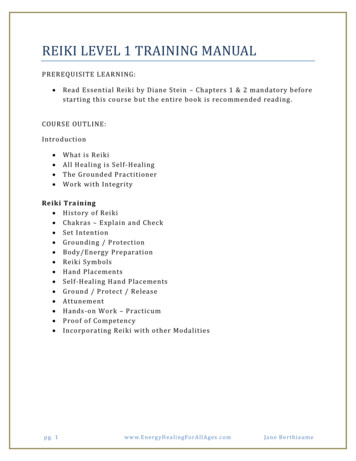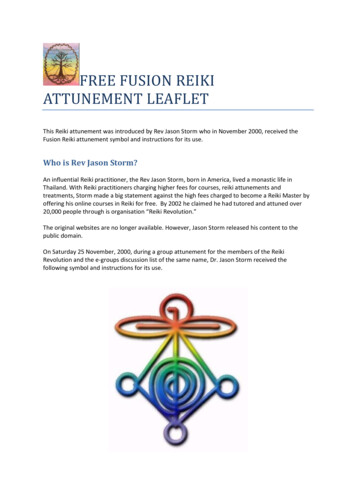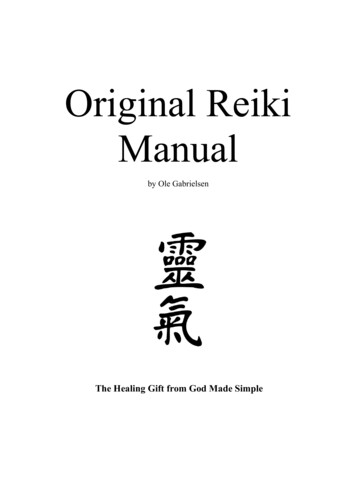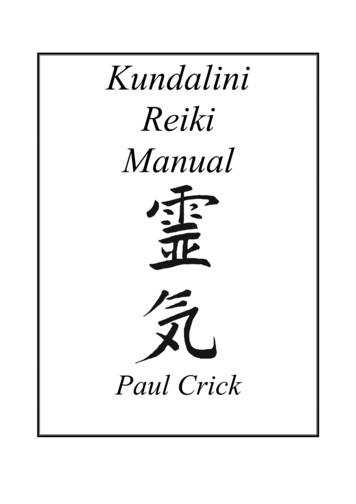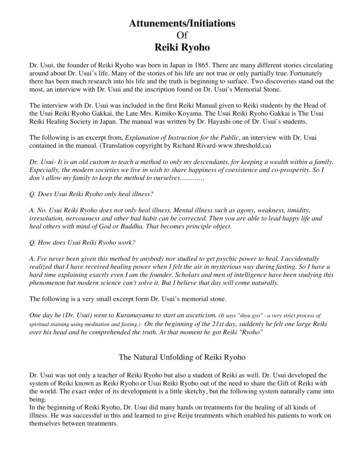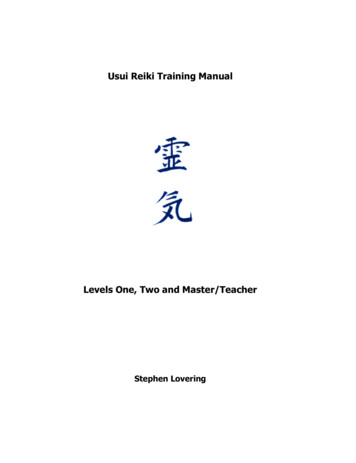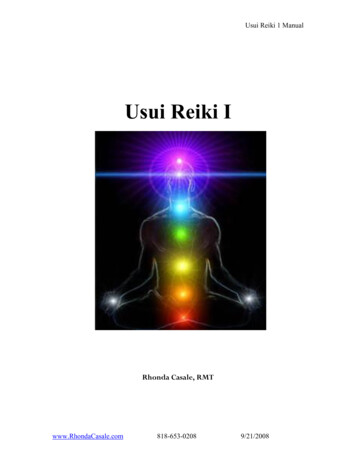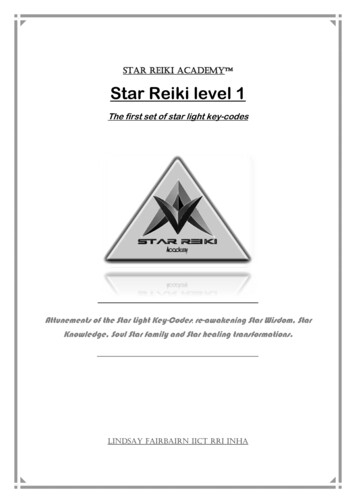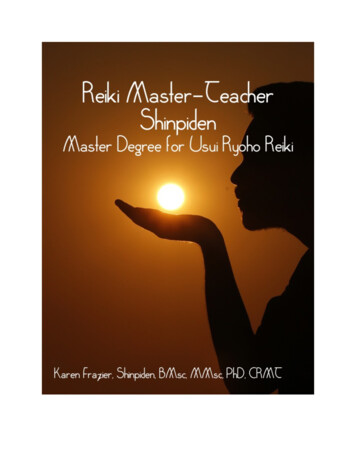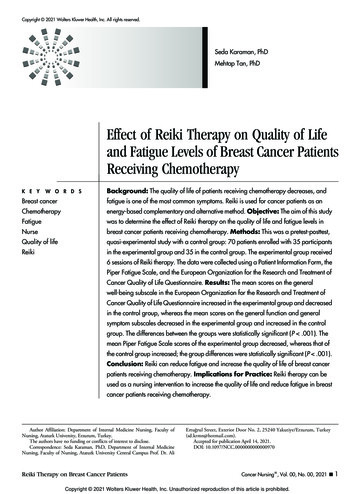
Transcription
Copyright 2021 Wolters Kluwer Health, Inc. All rights reserved.Seda Karaman, PhDMehtap Tan, PhDEffect of Reiki Therapy on Quality of Lifeand Fatigue Levels of Breast Cancer PatientsReceiving ChemotherapyK E YW O R D SBackground: The quality of life of patients receiving chemotherapy decreases, andBreast cancerfatigue is one of the most common symptoms. Reiki is used for cancer patients as anChemotherapyenergy-based complementary and alternative method. Objective: The aim of this studyFatiguewas to determine the effect of Reiki therapy on the quality of life and fatigue levels inNursebreast cancer patients receiving chemotherapy. Methods: This was a pretest-posttest,Quality of lifequasi-experimental study with a control group: 70 patients enrolled with 35 participantsReikiin the experimental group and 35 in the control group. The experimental group received6 sessions of Reiki therapy. The data were collected using a Patient Information Form, thePiper Fatigue Scale, and the European Organization for the Research and Treatment ofCancer Quality of Life Questionnaire. Results: The mean scores on the generalwell-being subscale in the European Organization for the Research and Treatment ofCancer Quality of Life Questionnaire increased in the experimental group and decreasedin the control group, whereas the mean scores on the general function and generalsymptom subscales decreased in the experimental group and increased in the controlgroup. The differences between the groups were statistically significant (P .001). Themean Piper Fatigue Scale scores of the experimental group decreased, whereas that ofthe control group increased; the group differences were statistically significant (P .001).Conclusion: Reiki can reduce fatigue and increase the quality of life of breast cancerpatients receiving chemotherapy. Implications for Practice: Reiki therapy can beused as a nursing intervention to increase the quality of life and reduce fatigue in breastcancer patients receiving chemotherapy.Author Affiliation: Department of Internal Medicine Nursing, Faculty ofNursing, Ataturk University, Erzurum, Turkey.The authors have no funding or conflicts of interest to disclose.Correspondence: Seda Karaman, PhD, Department of Internal MedicineNursing, Faculty of Nursing, Ataturk University Central Campus Prof. Dr. AliReiki Therapy on Breast Cancer PatientsErtuğrul Street, Exterior Door No. 2, 25240 Yakutiye/Erzurum, Turkey(sd.krmn@hotmail.com).Accepted for publication April 14, 2021.DOI: 10.1097/NCC.0000000000000970 Cancer NursingW, Vol. 00, No. 00, 2021Copyright 2021 Wolters Kluwer Health, Inc. Unauthorized reproduction of this article is prohibited.1
Cancer causes various difficulties and material andnon-material losses in individuals, and socio-economicburdens to society.1 In recent cancer statistics of the International Agency for Research on Cancer, women’s cancerswere especially noted. According to the GLOBOCAN 2018data, breast cancer is the second most common cancer type inthe world, the most commonly diagnosed cancer and the mostleading cause of cancer death among women. One of 4 womendiagnosed with cancer has breast cancer.2Certain current treatments applied to reduce mortality inbreast cancer patients have significant adverse effects that adversely affect patients’ physical, psychological, and social lifeand decrease their quality of life.3,4 Considering the qualityof life of breast cancer patients is important when evaluatingtreatment-related problems, providing patient integrated care,and planning the nursing care during treatment.5,6Developments in the medical field provide improved cancertreatment results causing cancer to become a chronic conditionby extending the lifespan. During this process, patients intenselyexperience both the disease process and treatment-related symptoms.1,7 Fatigue is the most common and inconvenient symptom in breast cancer patients; reported prevalence rates ofsevere fatigue range from 7% to 52%.8 Fatigue severely affectsthe quality of life of breast cancer patients.9 Previous studies showthat breast cancer patients experience high levels of fatigue, especially during treatment, and that even after treatment, fatiguedoes not always abate. In one-third of patients, fatigue persistedfor months and even years.9–12In recent years, important developments have been achievedin breast cancer management including surgery and adjuvantmedication.13 Despite these developments, treatment-relatedsymptoms are still commonly observed.14–16 Patients strive to reduce treatment-related symptoms and have a higher quality oflife using complementary and alternative therapies.17–19 Energytherapies have an important place in complementary and alternative therapy commonly used in breast cancer patients.20–22Reiki, applied by trained practitioners, is performed by activating the energy centers of the body, including blood and lymphcirculation and stimulating the nervous system, thereby enablingenergy circulation and positively affecting health by providingmental-physical relaxation.23–25 Studies investigating the effectof Reiki on cancer patients have shown that it can relieve pain,reduce anxiety and depression, improve quality of life, and reduce fatigue.26–29Caring indicates that an individual existentially has 3 fields: soul,mind, and body; synchronization of these 3 fields indicates ahealthy individual. With their approach, theoreticians such asRogers and Watson provide an important perspective and description to 21st-century nursing practices of professional nursing by physically, emotionally, and mentally evaluating careand recovery.33Evidence-based studies are needed regarding the effect ofReiki application, which is one of the energy-based complementary alternative therapy methods, on quality of life and fatigue inbreast cancer patients receiving chemotherapy. The purpose ofthis study was to determine the effect of Reiki therapy on thequality of life and fatigue levels in breast cancer patients receivingchemotherapy.nMethodsType of the StudyThis study used a pretest-posttest quasi-experimental design witha control group.Population and SampleThis study was conducted between February 2018 andSeptember 2019 in an outpatient chemotherapy unit of auniversity hospital in Turkey. The study population wascomposed of female patients with breast cancer who hadbeen admitted to the outpatient medical oncology clinic ofthe hospital between the dates of this study and who receivedchemotherapy in the outpatient chemotherapy unit. The studysample included patients who were between 18 and 54 years ofage, who previously received a minimum of 1 course of adjuvantchemotherapy and would receive at least 3 more courses of treatment, who did not have a psychiatric diagnosis, and who obtained 1 to 10 points on the Piper Fatigue Scale. The studysample was determined using the power analysis, which was carried out based on fatigue and quality-of-life mean scores obtainedfrom previous relevant studies.34,35 As a result, 70 patients wereincluded in the study, 35 for each group based on α .05 error,83.59% test power, and d 0.899 effect size.Data CollectionDATA COLLECTION TOOLSTheoretical FrameworkFor over 40 years, nurses providing complementary care adoptedthe concept of a human energy field and used energy-based modalities as professional interventions that support health and recovery. Reiki, which is one of the most commonly used energy-basedmodalities by American nurses, is an integrative recovery modelthat is used in various acute and chronic health problems.30,31The philosophy and principles of Reiki comply with the theoryand practices of nursing.32 Rogers’ Theory of Unitary Human Beings includes principles that indicate that humans and the environment interact with one another. Watson’s Theory of Human 2Cancer NursingW, Vol. 00, No. 00, 2021Data were collected using a Patient Information Form, the PiperFatigue Scale, and the European Organization for the Research and Treatment of Cancer Quality of Life Questionnaire (EORTC QLQ-C30).Patient Information Form: The patient information formincluded questions about patients’ marital status, age, education,chemotherapy protocol, disease duration, and disease stage.EORTC QLQ-C30 Scale: This quality-of-life measure includes 30 questions divided into 3 subscales: general wellbeing, general function, and general symptom. The items arescored as never, 1; a little, 2; pretty much, 3; and very much,Karaman and TanCopyright 2021 Wolters Kluwer Health, Inc. Unauthorized reproduction of this article is prohibited.
4. Lower scores indicate a higher quality of life. The scale scoreswere calculated by linearly converting the scores given to the answers to 100.36 The Cronbach’s α coefficient was .70 in the Turkish validity and reliability study.36 In this study, the Cronbach’s αcoefficient was .90.Piper Fatigue Scale: This scale evaluates an individual’s subjective perception of fatigue. The scale scoring is as follows: 0points no fatigue, 1 to 3 points mild level fatigue, 4 to 6points moderate level fatigue, and 7 to 10 points severe levelfatigue. The Cronbach’s α coefficient of this scale was .94 in theFigureTurkish validity and reliability study.37 In this study, theCronbach’s α coefficient was .95.Reiki ApplicationThe researcher, a second-degree Reiki therapist, performed the Reikitherapy. Reiki is applied touching the energy centers of the body(chakras). There are seven main and many small chakras on a body.Chakras are located on the front and back sides of the body in a Study plan.Reiki Therapy on Breast Cancer Patients Cancer NursingW, Vol. 00, No. 00, 2021Copyright 2021 Wolters Kluwer Health, Inc. Unauthorized reproduction of this article is prohibited.3
vertical line that runs along the middle of the body in humans. Acomplete Reiki therapy includes all the chakras and organs.38Patients were told to lie comfortably on their backs after theywere informed about the therapy. While the patient was receiving chemotherapy, each of the 14 Reiki hand positions was applied sequentially. Each of the hand positions took 3 minutes,requiring 42 minutes in total.Study ProcedureEligible participants were informed about the study by a nurseworking in the clinic who was independent from the study. Written and oral consents were obtained. Study tools were completedindependently by participants. To prevent possible group contamination, the control group’s data were collected first, and thenparticipants were enrolled in the experimental group.Participants in the control group completed the study toolsin the interview before the chemotherapy session. The tools werereadministered 1 week after the chemotherapy session in the firstinterview. In the second and third interviews, the tools wereagain administered the week after the chemotherapy sessionsfor both interviews. A total of 4 data points comprised the design:1 was pretest and 3 were posttest after each of 3 chemotherapysessions. After the study was completed, Reiki therapy was provided to patients in the control group who wanted to receive it.Participants in the experimental group completed all studytools in the pretest (before the intervention phase). A session ofReiki therapy was applied to these participants during the chemotherapy session that occurred in the first interview and for3 days following the chemotherapy because in chronic diseases,the initial application is recommended for 4 consecutive days.38The measurement tools were administered 1 week after the chemotherapy session. In the second and third interviews, a sessionof Reiki therapy was applied only during chemotherapy sessions;the measurement tools were readministered 1 week after the chemotherapy sessions in the second and third interviews. Participants received Reiki therapy for 6 sessions in total. A total of 4measurements were made: 1 was pretest and 3 were posttest after3 chemotherapy sessions (the Figure depicts the study plan).Data AnalysisThe data were analyzed using SPSS for Windows, Version 17.0.(SPSS Inc. Chicago, Illinois, Released 2008) software usingnumbers, percentages, mean, and SD, as well as χ2 analysis forthe comparison of the 2 groups’ demographic characteristics(categorical measurements), independent-group t test andMann-Whitney U test for the comparison of the groups’EORTC QLQ-C30 subscale scores and Piper Fatigue Scalescores, dependent-groups variance analysis and Friedman testfor intergroup comparisons, and Cronbach’s α coefficientsfor internal consistency.Ethical ConsiderationsBefore the study was conducted, a university ethics committeegranted its approval, and official written permission was obtained 4Cancer NursingW, Vol. 00, No. 00, 2021from the hospital in which the study was conducted. Verbal andwritten consent from the participating patients was obtained afterthey were informed about the study.nResultsPatients’ Sociodemographic andDisease-Related CharacteristicsIn the intervention group, 82.9% of participants were married,40.0% were in the 46- to 55-year age group, and 40% completedprimary school. Most (65.7%) of the experimental group participants’ disease duration was 12 months or less, 54.3% hadstage III cancer, and 45.7% received AC-P (adriamycincyclophosphamide-paclitaxel)–type adjuvant chemotherapy(Table 1).In the control group, 77.1% were married, 45.7% were inthe 36- to 45-year age group, and 45.7% completed primaryschool. Most (60.0%) of the control group participants’ diseaseduration was 12 months or less, 51.4% had stage II cancer, and40.0% received AC-P–type adjuvant chemotherapy (Table 1).Table 1 Introductory Characteristics of Patientsin the Intervention and Control GroupsExperimentalGroupMarital statusMarriedSingleAge, y25-3536-4546-5556-65Education levelLiteratePrimary schoolSecondary schoolHigh schoolUniversityDisease duration 12 mo 12 moDisease stageStage 2Stage 3Chemotherapy 877.1 χ2 0.35722.9 P .55061314217.137.140.05.83161338.6 χ2 1.54745.7 P .67137.18.63147838.640.020.022.98.651657214.3 χ2 1.23345.7 P .87314.320.05.7231265.734.3211460.0 χ2 0.24540.0 P .621161945.754.3181751.4 χ2 0.22948.6 P .6327571620.014.320.045.764111417.1 χ2 0.22911.4 P .63231.440.0Abbreviations: AC, adriamycin-cyclophosphamide; AC-P, adriamycincyclophosphamide-paclitaxel; CAF, cyclophosphamide-adriamycin-fluorouracil;CEF; cyclophosphamide-epirubicin-fluorouracil.a 2χ Test was administered.Karaman and TanCopyright 2021 Wolters Kluwer Health, Inc. Unauthorized reproduction of this article is prohibited.
Baseline characteristics of the experimental and control groups werestatistically similar and were distributed homogeneously (P .05)(Table 1).The Effect of Reiki Therapy on Patients’Quality of LifeTable 2 shows the patients’ mean EORTC QLQ-C30 scores obtained in the pretest and posttest first, second, and third measurements. In the pretest, no statistically significant difference wasfound between the groups’ mean scores on the general wellbeing, general function, and general symptom subscales of theQuality of Life Scale (P .05). In the first, second, and thirdmeasurements after the pretest, the differences between thegroups were statistically significant (P .001, P .001,P .001, respectively).The experimental group’s mean general well-being scoresgradually increased in the first, second, and third measurementsafter the pretest. The control group’s mean scores gradually decreased in the first, second, and third measurements after the pretest. In both groups, the differences within the groups werestatistically significant in the pretest and first, second, and thirdmeasurements (P .001, P .001, respectively).The experimental group’s mean general function subscaleand general symptom subscale scores gradually decreased in thefirst, second, and third measurements after the pretest. The control group’s mean scores gradually increased in the first, second,and third measurements after the pretest. In both groups,the differences within the groups were statistically significantin the pretest and first, second, and third measurements(P .001, P .001, respectively).Effect of Reiki Therapy on Patients’ FatigueLevelsTable 3 shows the patients’ pretest and posttest mean Piper Fatigue Scale scores. No statistically significant difference was foundbetween the groups in the pretest (P .05). In the first, second,and third measurements after the pretest, the differences betweenthe groups were statistically significant (P .001, P .001, andP .001, respectively).The experimental group’s total mean Fatigue Scale scoresgradually decreased in the first, second, and third measurementsafter the pretest The control group’s mean scores gradually increased in the first, second, and third measurements after the pretest. In both groups, the differences within the groups werestatistically significant in the pretest and first, second, and thirdmeasurements (P .001 and P .001, respectively).nDiscussionThis study investigated the effect of Reiki therapy on the qualityof life and fatigue levels in breast cancer patients receiving chemotherapy. Study results showed increased patient quality of life inthe Reiki therapy group (P .05). Orsak et al39 studied the effectof Reiki therapy on quality of life, mood, and symptom distressof adults receiving chemotherapy; quality of life of patients whoreceived Reiki therapy improved. A study at a cancer researchcenter investigated the effects of massage, yoga, and Reiki therapyon the well-being of patients with cancer. All 3 of the interventions reduced patients’ stress and anxiety levels and improvedtheir mental state, perceived general health state, and quality oflife. Reiki therapy reduced patients’ pain more than massage orTable 2 Intragroup and Intergroup Comparison of Mean European Organization for the Research and Treatmentof Cancer Quality of Life Questionnaire ScoresQuality of Life Scale SubscalesGeneral well-beingGroupPretestMean SDExperimental 31.90 15.3250.71 16.0862.61 11.1379.04 7.92Control37.14 13.1530.47 13.5420.00 10.547.14 7.86t 1.535P .130Experimental 44.57 15.41t 5.692P .00028.44 13.83t 16.441P .00017.33 8.17U 000.000P .0003.17 3.62Control38.81 16.8444.12 13.9455.42 11.7469.46 10.04t 1.481P .143Experimental 48.35 11.24t 4.724P .00031.79 12.86t 15.752P .00018.38 8.89U 000.000P .00013.18 1.09Control43.29 17.3746.81 16.0647.17 12.5762.49 12.89t 1.445P .154t 4.316P .000t 11.056P .000t 21.293P .000TestcGeneral functionTestcGeneral symptom1st Measurement 2nd Measurement 3rd MeasurementMean SDMean SDMean SDTestcTestF 99.519aP .000F 264.266bP .000F 100.055aP .000F 91.928aP .000F 239.668bP .000F 166.497bP .000aFriedman test was applied.Dependent groups’ variance analysis was administered.cIndependent-samples t test and Mann-Whitney-U test were applied.bReiki Therapy on Breast Cancer Patients Cancer NursingW, Vol. 00, No. 00, 2021Copyright 2021 Wolters Kluwer Health, Inc. Unauthorized reproduction of this article is prohibited.5
Table 3 Intragroup and Intergroup Comparison of Mean Piper Fatigue Scale ScoresGroupPretestMean SD1st MeasurementMean SD2nd MeasurementMean SD3rd MeasurementMean SDExperimental6.72 1.155.29 1.454.43 1.253.42 1.09Control6.64 1.217.03 1.027.67 0.858.40 0.73t 1.081P .284t 5.803P .000t 12.669P .000t 22.394P .000TestbabTestaF 398.916P .000F 365.892P .000Dependent groups’ variance analysis was administered.Independent-samples t test was administered.yoga.40 Tsang et al41 also found that Reiki therapy reduced adultpatients’ anxiety and pain and increased their general quality oflife. Kirshbaum et al42 investigated the Reiki experiences and perceptions of female adult cancer patients and documented increased relaxation, peace, tranquility, and sleep quality anddecreased depression and pain levels. In their study, Catlin andTaylor-Ford43 investigated the effect of Reiki therapy in patientswho received outpatient chemotherapy and found that Reiki significantly increased patients’ comfort and quality of life. Olsonet al29 investigated the effect of Reiki therapy on patients’ painand quality of life and determined that patients who receivedReiki therapy experienced less pain and improved quality of lifecompared with patients who used only opioids. In this study,similar to the results of other studies in which the effects of Reikiin cancer patients were determined, it was found that quality oflife increased significantly in the group that received Reiki therapy. Only breast cancer patients receiving adjuvant chemotherapy were included in this study and experimental-controlgroups were distributed homogeneously. No comparisons weremade in the study with other practices or placebo groups. For thisreason, it is thought that the effect of Reiki therapy in similargroups is shown more clearly. Reiki therapy is one of the integrative methods representing noninvasive and nonmedical, cost-freemethods, which contribute to and positively affect perceivedquality of life of cancer patients.40Findings on FatigueThe results of the current study showed that fatigue levels decreased in patients in the Reiki therapy group. In their study,Tsang et al41 documented that fatigue levels of patients who received Reiki had significantly decreased fatigue, whereas therewas no difference in the fatigue levels of the comparison restinggroup. In a study carried out in a cancer center to evaluate a voluntary Reiki program, Reiki therapy was administered to the patients, and fatigue levels were considerably reduced.28 Similar tothe study conducted by Tsang et al,41 fatigue was found to decrease in patients who received Reiki therapy. Unlike Tsangand colleagues’41 study, whereas fatigue of the patients decreasedgradually in the patients who received Reiki therapy, fatigue inthe control group increased gradually, and the difference betweengroups was found to be significant in the present study. The reason for this may be associated with the higher number of samplein this study. Demir et al27 carried out a study to investigate theeffect of distant Reiki therapy on pain, anxiety, and fatigue in 6Cancer NursingW, Vol. 00, No. 00, 2021oncology patients and found that the fatigue levels of the groupwho received Reiki therapy were significantly less than the fatiguelevels of the control group. The results of this study are similar to theresults of Demir and colleagues’27 study. In patients with breast cancer, there is no criterion standard for nonpharmacological treatment,but various nonpharmacological approaches have shown positive effects in the treatment of fatigue.9nConclusionIn this study, which was carried out to determine the effect ofReiki therapy on quality of life and fatigue levels in breast cancerpatients receiving chemotherapy, the quality of life of patientswho received Reiki increased, their general function levels increased, they experienced fewer symptoms, and their perceivedfatigue levels were reduced. These results suggest that the administration of Reiki therapy with chemotherapy as a complementary treatment increases the quality of life and reduces fatiguelevels. However, future studies are needed to determine the effectiveness of Reiki therapy.References1. Ovayolu Ö. Onkolojik problemler ve hemşirelik yönetimi [Oncologicalproblems and nursing management]. In: Ovayolu N, Ovayolu Ö, eds.Temel iç hastalıkları hemşireliği ve farklı boyutlarıyla kronik hastalıklar[Basic internal diseases nursing and chronic diseases with differentdimensions]. Adana, Turkey: Çukurova Nobel Medical Bookstore; 2016:461–478.2. Bray F, Ferlay J, Soerjomataram I, Siegel RL, Torre LA, Jemal AJ. Globalcancer statistics 2018: GLOBOCAN estimates of incidence and mortalityworldwide for 36 cancers in 185 countries. CA Cancer J Clin. 2018;68(6):394–424.3. Özkan S, Alçalar N. Meme kanserinin cerrahi tedavisine psikolojik tepkiler[Psychological reactions to surgical treatment in breast cancer]. J BreastHealth. 2009;5(2):60–64.4. Shandiz FH, Karimi FZ, Rahimi N, et al. Investigating sexual function andaffecting factors in women with breast cancer in Iran. Asian Pac J CancerPrev. 2016;17(7):3583–3586.5. Runowicz CD, Leach CR, Henry NL, et al. American Cancer Society/American Society of Clinical Oncology breast cancer survivorship careguideline. CA Cancer J Clin. 2016;66(1):43–73.6. Greenlee H, DuPont-Reyes MJ, Balneaves LG, et al. Clinical practiceguidelines on the evidence-based use of integrative therapies during andafter breast cancer treatment. CA Cancer J Clin. 2017;67(3):194–232.7. Büker N, Şen F. Onkoloji hastasın da kemoterapi ve bakım [Chemotherapyand care in oncology patient]. In: Can G, ed. Onkoloji Hemşireliği [OncologyNursing]. Istanbul, Turkey: Nobel Medical Bookstore; 2015:205–215.Karaman and TanCopyright 2021 Wolters Kluwer Health, Inc. Unauthorized reproduction of this article is prohibited.
8. Abrahams HJG, Gielissen MFM, Schmits IC, Verhagen CAHHVM,Rovers MM, Knoop H. Risk factors, prevalence, and course of severefatigue after breast cancer treatment: a meta-analysis involving 12 327breast cancer survivors. Ann Oncol. 2016;27(6):965–974.26. Birocco N, Guillame C, Storto S, et al. The effects of Reiki therapy on painand anxiety in patients attending a day oncology and infusion services unit.Am J Hosp Palliat Care. 2012;29(4):290–294.9. Berger AM, Gerber LH, Mayer DK. Cancer-related fatigue: implications forbreast cancer survivors. Cancer. 2012;118(8 suppl):2261–2269.27. Demir M, Can G, Kelam A, Aydiner A. Effects of distant Reiki on pain,anxiety and fatigue in oncology patients in Turkey: a pilot study. AsianPac J Cancer Prev. 2015;16(12):4859–4862.10. Peoples AR, Roscoe JA, Block RC, et al. Nausea and disturbed sleep aspredictors of cancer-related fatigue in breast cancer patients: a multicenterNCORP study. Support Care Cancer. 2017;25(4):1271–1278.28. Fleisher KA, Mackenzie ER, Frankel ES, Seluzicki C, Casarett D, Mao JJ.Integrative Reiki for cancer patients: a program evaluation. Integr CancerTher. 2014;13(1):62–67.11. Schmidt ME, Chang-Claude J, Seibold P, et al. Determinants of long-termfatigue in breast cancer survivors: results of a prospective patient cohortstudy. Psychooncology. 2015;24(1):40–46.12. Schmidt ME, Chang-Claude J, Vrieling A, Heinz J, Flesch-Janys D,Steindorf K. Fatigue and quality of life in breast cancer survivors:temporal courses and long-term pattern. J Cancer Surviv. 2012;6(1):11–19.13. Kolberg HC, Schneeweiss A, Fehm TN, et al. Update breast cancer 2019part 3 - current developments in early breast cancer: review and criticalassessment by an international expert panel. Geburtshilfe Frauenheilkd.2019;79(5):470–482.14. Savard J, Ivers H, Savard MH, Morin CM. Cancer treatments and their sideeffects are associated with aggravation of insomnia: results of a longitudinalstudy. Cancer. 2015;121(10):1703–1711.15. Tao JJ, Visvanathan K, Wolff AC. Long term side effects of adjuvantchemotherapy in patients with early breast cancer. Breast. 2015;24 suppl 2(02):S149–S153.16. Whisenant M, Wong B, Mitchell SA, Beck SL, Mooney K. Distincttrajectories of fatigue and sleep disturbance in women receivingchemotherapy for breast cancer. Oncol Nurs Forum. 2017;44(6):739–750.17. Mohd Mujar NM, Dahlui M, Emran NA, et al. Complementary andalternative medicine (CAM) use and delays in presentation and diagnosisof breast cancer patients in public hospitals in Malaysia. PLoS One. 2017;12(4):e0176394.18. Naja F, Fadel RA, Alameddine M, et al. Complementary and alternativemedicine use and its association with quality of life among Lebanesebreast cancer patients: a cross-sectional study. BMC Complement AlternMed. 2015;15:444.29. Olson K, Hanson J, Michaud M. A phase II trial of Reiki for themanagement of pain in advanced cancer patients. J Pain SymptomManage. 2003;26(5):990–997.30. Frisch N, Butcher HK, Campbell D, Weir-Hughes D. Holistic nurses’ useof energy-based caring modalities. J Holist Nurs. 2018;36(3):210–217.31. Ringdahl D. Reiki. In: Lindquist R, Tracy MF, Snyder M, eds.Complementary and Alternative Therapies in Nursing. New York: SpringerPublishing Company; 2018:411–430.32. Alarcão Z, Fonseca JRS. The effect of Reiki therapy on quality of life ofpatients with blood cancer: results from a randomized controlled trial.Eur J Integ Med. 2016;8(3):239–249.33. Kryak E, Vitale A. Reiki and its journey into a hospital setting. Holist NursPract. 2011;25(5):238–245.34. Özkaraman A, Metcalfe E, Kersu Ö, et al. The effect of light on quality ofsleep and life in breast cancer patients. J Turk Sleep Med. 2018;5:17–22.35. Demiralp M, Oflaz F, Kömürcü S. Effects of relaxation training on sleepquality and fatigue in patients with breast cancer undergoing adjuvantchemotherapy. J Clin Nurs. 2010;19:1073–1083.36. Güzelant A, Göksel T, Özkök S, Taşbakan S, Aysan T, Bottomley A. TheEuropean Organization for Research and Treatment of Cancer QLQC30: an examination into the cultural validity and reliability of theTurkish version of the EORTC QLQ-C30. Eur J Cancer Care. 2004;13(2):135–144.37. Can G. Meme kanserli hastalarda yorgunluğun ve bakım gereksinimlerinindeğerlendirilmesi [Assessment of fatigue and care needs in patients with breastcancer] [doctoral thesis]. Istanbul, Turkey: Istanbul Üniversitesi; 2001.19. Ong’udi M, Mutai P, Weru I. Study of the use of complementary andalternative medicine by cancer patients at Kenyatta National Hospital,Nairobi, Kenya. J Oncol Pharm Pract. 2019;25(4):918–928.38. Bülbül İ. Reiki İlahi Aydınlanma [Reiki Divine Enlightenment]. Istanbul,Turkey: Melisa Publisher; 2016.20. Bahall M. Prevalence, patterns, and perceived value of complementary andalternative medicine among cancer patients: a cross-sectional, descriptivestudy. BMC Complement A
Reiki Application The researcher, a second-degree Reiki therapist, performed the Reiki therapy. Reiki is applied touching the energy centers of the body (chakras). There are seven main and many small chakras on a body. Chakras are located on the front and back sides of the body in a Figure Study plan.
